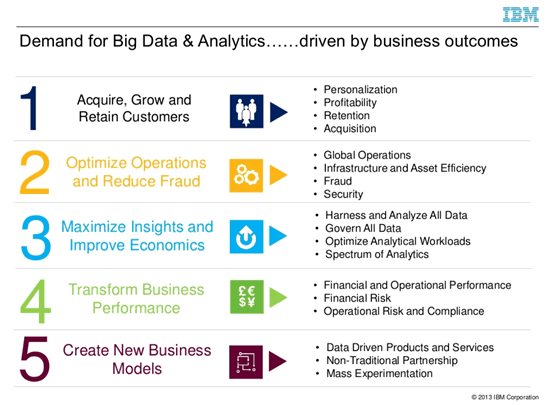Analytics and big data have always been close friends. As Neil Isford (VP, Smarter Analytics, IBM North America), once said “analytics is about providing people with trusted, relevant and timely information to address business outcomes”.
In a presentation he gave at the Global Directions conference, Isford mentioned research conducted with the Saïd Business School at the University of Oxford, showing that customer analytics are driving big data initiatives. Furthermore, initial big data efforts are focused on gaining insights from existing and new sources of internal data.
Leveraging information for business analytics, decision making, assessing value and ensuring frictionless sharing of information will be a defining capability of the most successful companies (Gartner)
Yet, at the same time big data requires strong analytics capabilities and it’s a well-known fact that, among the obstacles to widespread big data and analytics adoption are a lack of the needed skills, along with a lack of understanding how to use analytics to improve the business. So, how can they use them? Isford provides examples in the video at the bottom of this page.
Big data analytics: driven by business outcomes
Analytics, more specifically predictive analytics, was the first technology to reach the plateau of productivity in Gartner’s Hype Cycle for Big Data and other information- and analytics-related Big Data topics have been steadily on the rise (e.g. big data analytics for e-commerce and customer service) or moving towards the slope of enlightenment (social analytics, sales analytics and content analytics).
The main reason why big data analytics is so important, is probably best reflected in the infographic at the bottom of this page, made by the team behind European digital business event CeBIT: companies that use (big data) analytics are 5 times more likely to make decision much faster than their competitors and 50% say that big data helps to better meet consumer demand and facilitate growth.

Big data analytics: turning data into insight into action with smart data
At the Global Directions conference, Neil Isford, also showed research data, indicating that nearly two out of three respondents realize a competitive advantage from information and (big data) analytics.

As mentioned, Isford further provided some examples in a keynote on Big Data and analytics. Isford emphasizes we are past the early adoption stage of big data. While in Gartner’s Hype Cycle for emerging technologies, big data in general is beyond the peak of inflated expectations, real life examples show a different picture when it boils down to analytics, as is also confirmed by the earlier mentioned Hype Cycle for Big Data.
For Isford it’s clear that companies are seeing significant competitive advantages from big data analytics, increasing market share, while others earn competitive exposure because they’re not.
The essence, according to Isford: it’s really about turning information into insight and insight into action. In other words: actionable and smart data and information management.
Or: the right information, insights and actions for the right reasons to the right people at the right time.


